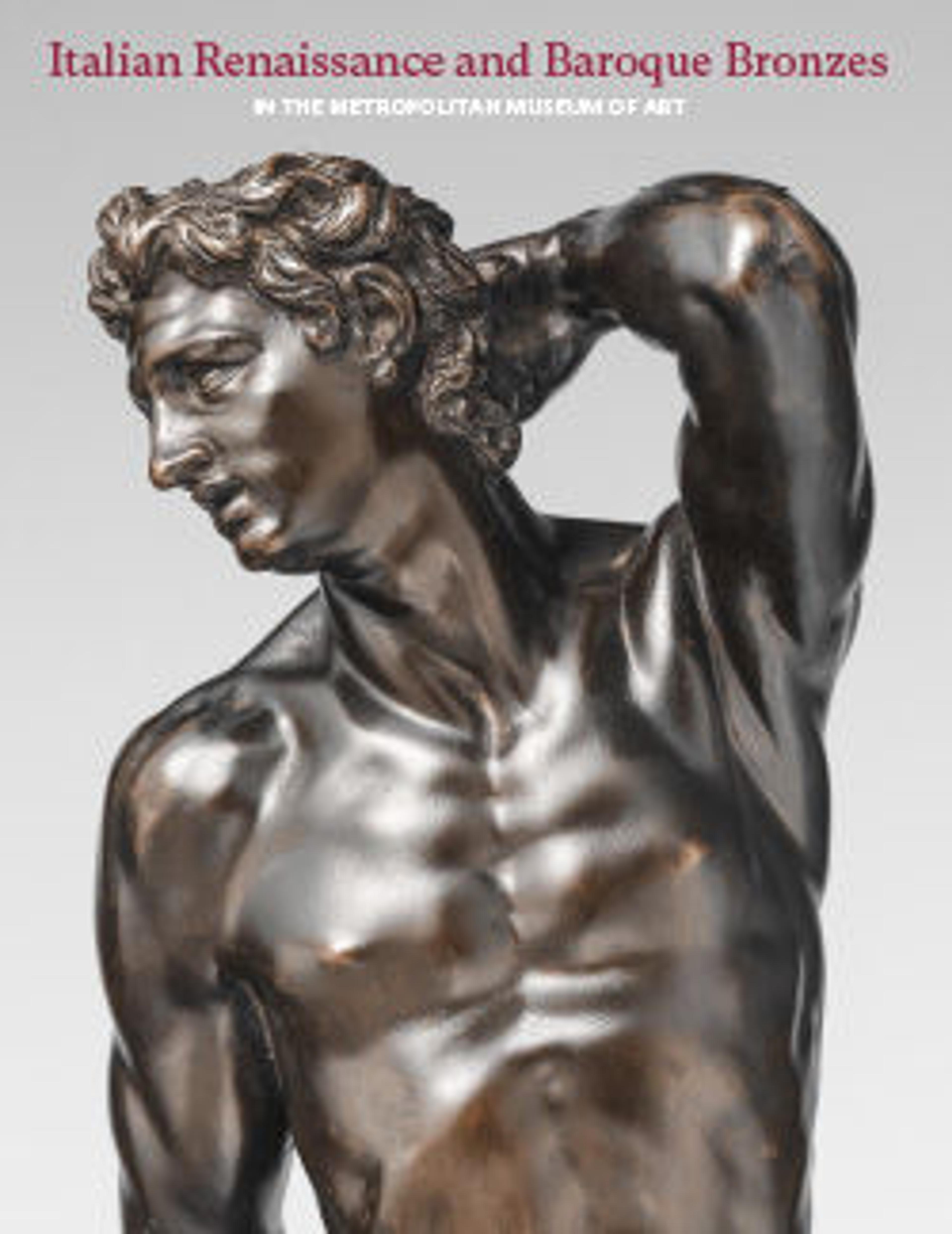The crucified Christ
The statuette is a variation of the Cristo morto (Dead Christ) composition invented by Giambologna. At least two exemplars were cast by the master around 1588 in Florence, one as a gift to the convent of Santa Maria degli Angiolini, the other for the Salviati Chapel in the Dominican church of San Marco.[1] Both are larger than our replica (respectively, 46.8 and 45.8 cm). Antonio Susini and his workshop produced several bronze reductions based on Giambologna’s autograph works.[2] James David Draper assigned our crucifix to Susini’s shop.[3]
According to Richard Stone, the bronze seems to be a direct cast and, with solid legs and arms, is quite heavy.[4] Most of its patina has worn away, with many visible copper plugs scattered over the darker bronze body of Christ. It is not easily comparable to Giambologna’s crucifixes or Susini’s reductions. Skepticism about its chronology derives from several factors: the highly detailed muscling of the anatomy and chiseling of the hair, its considerable weight, and the style, which is far removed from Giambologna, Susini, or any other seventeenth-century Florentine sculptor. All of these elements point to a much later date for our cast, perhaps the eighteenth or nineteenth century. Compositionally and stylistically, it has more in common with a gilded nude corpus (40.6 cm) that has the prestigious provenance of the Viennese Geistliche Schatzkammer but whose origins await clarification, and with a larger bronze crucifix (46.4 cm) problematically attributed to Pietro Tacca.[5] However, the similarities are not robust enough to assume the three works came from the same workshop.
-FL
Footnotes
(For key to shortened references see bibliography in Allen, Italian Renaissance and Baroque Bronzes in The Metropolitan Museum of Art. NY: The Metropolitan Museum of Art, 2022.)
1. See C. Avery and Radcliffe 1978, pp. 143–46.
2. See Denise Allen in Wengraf 2014, pp. 158–63, cat. 10; Gasparotto 2011a. On the relationship between Giambologna and Susini, see Zikos 2013.
3. Linsky 1984, p. 153.
4. Radiographs also show other features that differ from the Giambologna workshop, including transfixing core pins and unthreaded plugs of a different colored alloy than the cast, which were presumably originally hidden by an opaque, dark patina. R. Stone/TR, 2011.
5. Kunsthistorisches Museum, SK GS E 19; see Manfred Leithe-Jasper in C. Avery et al. 1978, p. 195, cat. 107a. For the crucifix attributed to Tacca, see Michael Hall in C. Avery and Hall 1999, pp. 107–9, cat. 23.
According to Richard Stone, the bronze seems to be a direct cast and, with solid legs and arms, is quite heavy.[4] Most of its patina has worn away, with many visible copper plugs scattered over the darker bronze body of Christ. It is not easily comparable to Giambologna’s crucifixes or Susini’s reductions. Skepticism about its chronology derives from several factors: the highly detailed muscling of the anatomy and chiseling of the hair, its considerable weight, and the style, which is far removed from Giambologna, Susini, or any other seventeenth-century Florentine sculptor. All of these elements point to a much later date for our cast, perhaps the eighteenth or nineteenth century. Compositionally and stylistically, it has more in common with a gilded nude corpus (40.6 cm) that has the prestigious provenance of the Viennese Geistliche Schatzkammer but whose origins await clarification, and with a larger bronze crucifix (46.4 cm) problematically attributed to Pietro Tacca.[5] However, the similarities are not robust enough to assume the three works came from the same workshop.
-FL
Footnotes
(For key to shortened references see bibliography in Allen, Italian Renaissance and Baroque Bronzes in The Metropolitan Museum of Art. NY: The Metropolitan Museum of Art, 2022.)
1. See C. Avery and Radcliffe 1978, pp. 143–46.
2. See Denise Allen in Wengraf 2014, pp. 158–63, cat. 10; Gasparotto 2011a. On the relationship between Giambologna and Susini, see Zikos 2013.
3. Linsky 1984, p. 153.
4. Radiographs also show other features that differ from the Giambologna workshop, including transfixing core pins and unthreaded plugs of a different colored alloy than the cast, which were presumably originally hidden by an opaque, dark patina. R. Stone/TR, 2011.
5. Kunsthistorisches Museum, SK GS E 19; see Manfred Leithe-Jasper in C. Avery et al. 1978, p. 195, cat. 107a. For the crucifix attributed to Tacca, see Michael Hall in C. Avery and Hall 1999, pp. 107–9, cat. 23.
Artwork Details
- Title: The crucified Christ
- Founder: Workshop of Antonio Susini (Italian, 1558–1624 Florence)
- Modeler: After a model by Giambologna (Netherlandish, Douai 1529–1608 Florence)
- Date: Model: early 17th century; cast: 18th or 19th century
- Culture: Italian, Florence
- Medium: Bronze
- Dimensions: Height: 14 in. (35.6 cm)
- Classification: Sculpture-Bronze
- Credit Line: The Jack and Belle Linsky Collection, 1982
- Object Number: 1982.60.101
- Curatorial Department: European Sculpture and Decorative Arts
More Artwork
Research Resources
The Met provides unparalleled resources for research and welcomes an international community of students and scholars. The Met's Open Access API is where creators and researchers can connect to the The Met collection. Open Access data and public domain images are available for unrestricted commercial and noncommercial use without permission or fee.
To request images under copyright and other restrictions, please use this Image Request form.
Feedback
We continue to research and examine historical and cultural context for objects in The Met collection. If you have comments or questions about this object record, please contact us using the form below. The Museum looks forward to receiving your comments.
